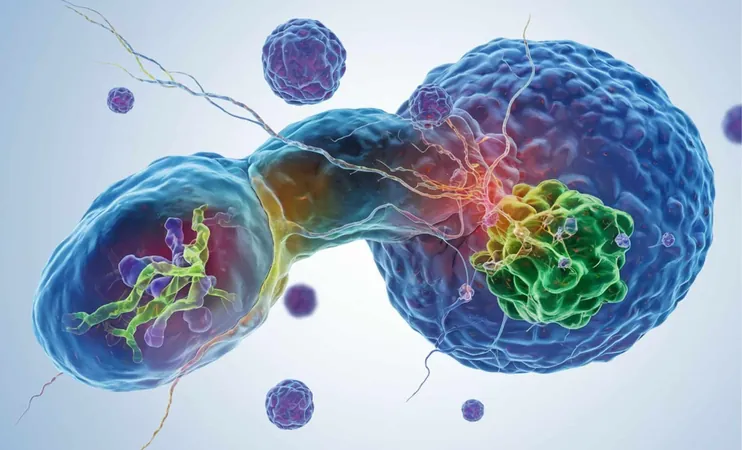
Breakthrough Discovery: Scientists Identify Key Enzyme Driving Pancreatic Cancer Growth, Paving the Way for Revolutionary Treatments
2025-01-02
Author: Ming
Pancreatic cancer, notoriously known as one of the deadliest cancers, claims nearly 50,000 lives each year in the United States alone, as reported by the National Cancer Institute. Despite ongoing advancements in cancer research, the survival rates for this aggressive disease are alarmingly low. A groundbreaking study from the University of California, San Diego (UC San Diego) School of Medicine has uncovered the pivotal role of the enzyme MICAL2 in the development and progression of pancreatic ductal adenocarcinoma (PDAC), marking a significant step forward in the fight against this ruthless cancer.
Published in Cancer Research on January 2, 2025, this cutting-edge research sheds light on how MICAL2 not only supports tumor growth but also aids in the metastasis of cancer cells, establishing it as a crucial player in the progression of pancreatic cancer. This revelation could lead to novel approaches in treatment options that are sorely needed in a field where current methodologies often fall short.
The Game-Changing Role of MICAL2 in Pancreatic Cancer
Traditionally viewed as a regulator of cell structure and movement, MICAL2 has now emerged as a critical player in cancer biology. The study found that levels of MICAL2 are significantly elevated in pancreatic cancer cells compared to normal cells, suggesting its involvement goes beyond conventional cellular functions.
Several notable findings arose from this study:
1. Impact on Patient Survival: Research has revealed a strong correlation between MICAL2 expression levels and patient outcomes. Patients who underwent surgical removal of PDAC tumors with lower MICAL2 levels had an impressive survival rate, living approximately twice as long as those with higher MICAL2 expressions, underscoring the enzyme’s active role in influencing disease outcomes.
2. Interaction with the KRAS Pathway: MICAL2 interacts closely with the KRAS signaling pathway, which is a well-known contributor to tumor growth and metastasis. Specifically, tumor cells that lacked MICAL2 demonstrated decreased KRAS activity, disrupting cancer cell proliferation and spread.
3. Enhancing Tumor Dynamics: Notably, MICAL2 plays a crucial role in promoting cancer cell division and migration into surrounding healthy tissues, further confirming its influence on tumor aggressiveness and spread.
A Shift in Treatment Paradigms for Pancreatic Cancer
The findings from this study prompt a reevaluation of treatment strategies for pancreatic cancer. Current therapies tend to focus on alleviating symptoms in advanced stages, as opposed to strategically targeting the molecular underpinnings that drive tumor growth. MICAL2 represents a promising, druggable target, enabling the development of therapies that could disrupt the processes that fuel pancreatic cancer.
Dr. Andrew Lowy, a distinguished professor at UC San Diego School of Medicine, stated, “Pancreatic cancer has the highest mortality rate among common cancers, and current treatments remain grossly insufficient.” Targeting MICAL2 could offer a groundbreaking approach to inhibit the mechanisms driving tumor proliferation and metastasis.
Expanding Horizons in Cancer Research
This study not only highlights the role of MICAL2 in pancreatic cancer but also opens doors for understanding the roles of similar enzymes in other forms of cancer. The intricate relationship between MICAL2 and KRAS activity could inspire innovative treatment avenues for other KRAS-driven tumors, which account for a significant percentage of cancers.
As researchers work diligently to discover compounds that can inhibit MICAL2’s activity, the goal is to transition these findings from lab studies to clinical applications. This new avenue may provide a more targeted strategy in combating pancreatic cancer, a disease that has historically resisted standard treatment protocols.
Stay tuned for the latest developments in cancer research, as this discovery could redefine how we approach one of medicine’s toughest challenges!



 Brasil (PT)
Brasil (PT)
 Canada (EN)
Canada (EN)
 Chile (ES)
Chile (ES)
 Česko (CS)
Česko (CS)
 대한민국 (KO)
대한민국 (KO)
 España (ES)
España (ES)
 France (FR)
France (FR)
 Hong Kong (EN)
Hong Kong (EN)
 Italia (IT)
Italia (IT)
 日本 (JA)
日本 (JA)
 Magyarország (HU)
Magyarország (HU)
 Norge (NO)
Norge (NO)
 Polska (PL)
Polska (PL)
 Schweiz (DE)
Schweiz (DE)
 Singapore (EN)
Singapore (EN)
 Sverige (SV)
Sverige (SV)
 Suomi (FI)
Suomi (FI)
 Türkiye (TR)
Türkiye (TR)
 الإمارات العربية المتحدة (AR)
الإمارات العربية المتحدة (AR)